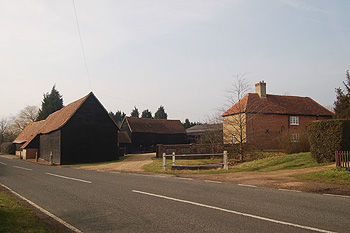Cotton End Farm Wilshamstead

Cotton End Farm March 2012
Number 229 Cotton End Road is Cotton End Farmhouse. It was listed by English Heritage in May 1984 as Grade II, of special interest. The house dates from the 17th century and 18th and 19th century alterations and additions. Two inscribed bricks read: “T. K. 1776” giving a date for some of the alterations.
The house is mainly timber-framed and covered with pebbledash rendering though an addition to the north-west end is in brick. The property comprises two storeys, in an L-shape, beneath clay tiled roofs. The porch is 20th century.
The farm formed part of the Haynes Estate, owned by the Lords Carteret. When this title became extinct the family reverted to its original surname of Thynne and continued to hold the estate until July 1914 when it was put up for sale by auction in over two hundred lots. Cotton End Farm formed part of the estate and may, originally, have been owned by the Manor of Wilshamstead, itself part of the estate.
The sale particulars [Z720/1/16] had Cotton End Farm as Lot 94, describing it as: “A Capital Freehold Farm known as Cotton End comprising a convenient Farm House and good buildings, together with about 97 acres 3 roods 17 poles of which 23 Acres are Grass and 74 Acres Arable Land”. The farmhouse was described as containing two living rooms, a kitchen with a copper for heating water, a dairy, a cellar and four bedrooms. The farm buildings included a timber and tiled granary, two pigsties, a cowhouse, two two-bay hovels, two timber and tiled barns, a cowhouse for three, a carthorse stable for four, a cart shed and an enclosed yard. The tenants were P. and J. Hallworth whose rent was £62 per annum. The particulars are annotated: “Sold £1930”
The Rating and Valuation Act 1925 specified that every building and piece of land in the country was to be assessed to determine its rateable value. Like most of the county, Wilshamstead was largely assessed in 1927 and the valuer visiting Manor Farm [DV1/H42/6] found that it was owned by T. Handley (presumably the buyer in 1914) and farmed by George Leonard Handley who paid rent of £150, set in 1922, for 204 acres. The valuer commented: “Heavy land, water from well”.
The farmhouse comprised a hall, two reception rooms, a kitchen, scullery, dairy and larder with four bedrooms, a bathroom and W. C. above and an attic above that. A cellar ran beneath the ground floor. Outside stood a coal house, a coach house and a harness room. The homestead comprised the following: a trap house; two loose boxes; a further loose box; a stable for six horses; a four bay open shed; two more loose boxes; a dairy; a cowhouse for eighteen; a barn; a cowhouse for four; an implement shed; a five bay cart hovel; a store; an open corrugated iron implement shed; another barn; three piggeries; two henhouses; a pump house; two further loose boxes; a four bay hove and a granary. Construction of the homestead was a combination of brick and slate, brick and tile and weather-boarding and thatch.
Directories for Bedfordshire were not published every year but every few years from the early to mid 19th century until 1940. Cotton End Farm is listed in a directory of 1877, when it was farmed by Henry John Peacock and in 1910 and 1914 when the tenant was Jonathan Hallworth. Directories reveal that the Handley family, as well as Cotton End Farm, had Manor Farm further west along Cotton End Road.